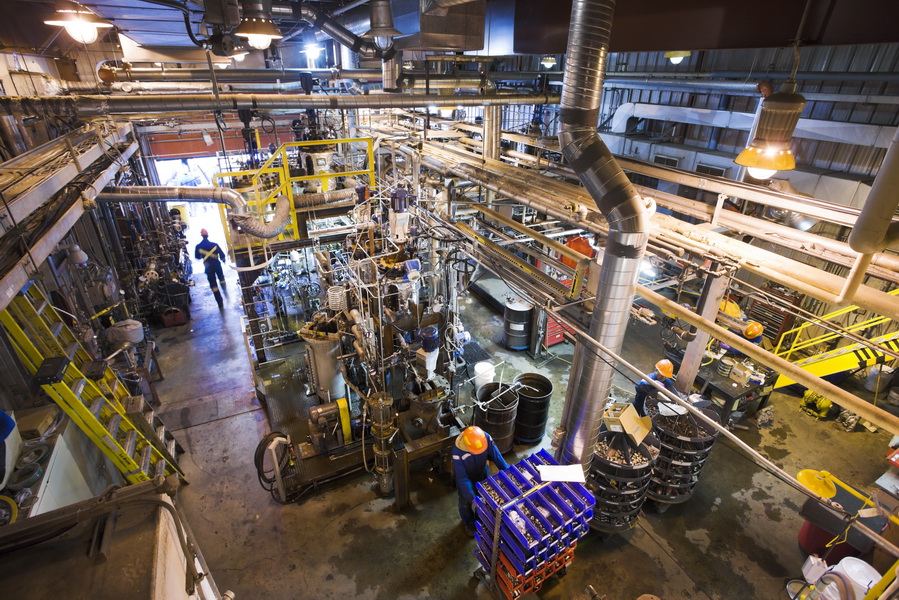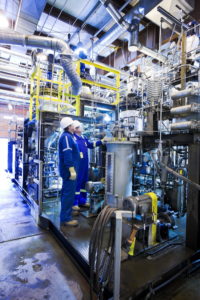Organizations:
People:
Topics:
Creating value from oil sands waste
Rebecca MelvilleJuly 19, 2017
This article is from the March 2017 issue of Canadian Innovation News. You can read the full issue here.
After oil sands are processed into bitumen, the by-product (a mix of water, sand and residual oil) is deposited into tailings ponds. Yet there’s still some value to be found in this waste. Scott Nelson, president and CEO of Titanium Corporation, explains how his clean tech company is recovering valuable minerals that would otherwise be lost—and reducing the carbon footprint of the oil sands industry.
The Calgary company is currently working with industry and government to commercialize its Creating Value from Waste™ suite of technologies.
 Titanium’s bitumen recovery circuit (Photo: Titanium Corp.)
Titanium’s bitumen recovery circuit (Photo: Titanium Corp.)
Q: How does your technology fit into the oil sands process?
Nelson: Our goal is to maximize the value existing in the waste material currently being deposited in tailings ponds. The final stage of bitumen extraction occurs in what’s called the froth treatment plant—but rather than letting the plant discharge directly into the tailings pond, we divert its pipeline to our facilities where we apply a second stage of treatment to the waste. Using a combination of industrial processes such as cycloning, floatation and gravitational separation, we can recover valuable commodities from the waste tailings, including residual bitumen, solvents and heavy minerals like zircon and titanium.
We like to say our technology offers a triple bottom line: it delivers economic, environmental and social responsibility improvements.
[rs_quote credit="Scott Nelson" source="Titanium Corporation"]We like to say our technology offers a triple bottom line: it delivers economic, environmental and social responsibility improvements.[/rs_quote]
Q: What sort of environmental benefits are we talking about?
Nelson: By intercepting oil, solvents and other commodities before they reach the tailings ponds,
our technology can reduce the ponds’ volatile organic compound (VOC) emissions by about 70% and greenhouse gas (GHG) emissions by about 10%. And by improving the quality of water that’s discharged into the tailings ponds, more of it can be recycled into oil sands operations, reducing the need to use fresh river water by about 20%.
Q: What does all of that mean for Canadians?
Nelson: Some people talk about ‘greening’ the oils sands—and this is certainly one part of the answer to the challenges we’re facing here in Alberta. By using sustainable technology to reduce the environmental footprint of the oil sands industry and improve the way it delivers its product, we’re helping make the case for Canadian oil to access more markets in the United States and around the world.
[caption id="attachment_10967" align="alignright" width="200"] Titanium president/CEO Scott Nelson with Dr. Kevin Moran,
Titanium president/CEO Scott Nelson with Dr. Kevin Moran,
executive VP & CTO beside the company’s solvent recovery
technology unit (Photo: Titanium Corp.)[/caption]
[rs_quote credit="Scott Nelson" source="Titanium Corporation"]Right now, the Athabasca oil sands are known for just one thing: producing oil. But most people don’t know that they also have the potential become the world’s greenest source of titanium, zircon and other minerals. [/rs_quote]
Q: What’s the coolest thing about this project?
Nelson: Right now, the Athabasca oil sands are known for just one thing: producing oil. But most people don’t know that they also have the potential become the world’s greenest source of titanium, zircon and other minerals. The reason it’s greener is because the minerals have already been extracted, so there’s no mining involved. All we need to do is reach into the tailings and recover them — and in doing so, create a new mineral export industry for Canada.
Looking ahead
What is the biggest challenge facing Titanium Corporation? According to Nelson, it’s the long development and commercialization cycle that comes with a large, complex industry like the oil sands. But after more than eight years of research and development—and more than $80 million invested by shareholders and government partners, including Sustainable Development Technology Canada, Nelson says his technology is ready to go live.
“We have just completed several years of demonstration piloting,” he says. “Now we’re working with the oil sands operators to show them what would be involved in implementing our technology at their sites—and to figure out who will be the first adopter of this technology. This planning process will also take time, but we’re very optimistic that we have a viable solution for a very important industry in Canada.”
Read the 2016 scientific paper on the technology "New Oil Sands Technology to Meet the Challenges of Climate Change and Tailings Management"
Source: Canadian Museum of Science and Technology Corp.’s Let’s Talk Energy Series

This article is from the March 2017 issue of Canadian Innovation News. You can read the full issue here.
Events For Leaders in
Science, Tech, Innovation, and Policy
Discuss and learn from those in the know at our virtual and in-person events.
See Upcoming Events
By using this website, you agree to our use of cookies. We use cookies to provide you with a great experience and to help our website run effectively in accordance with our Privacy Policy and Terms of Service.




